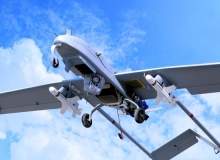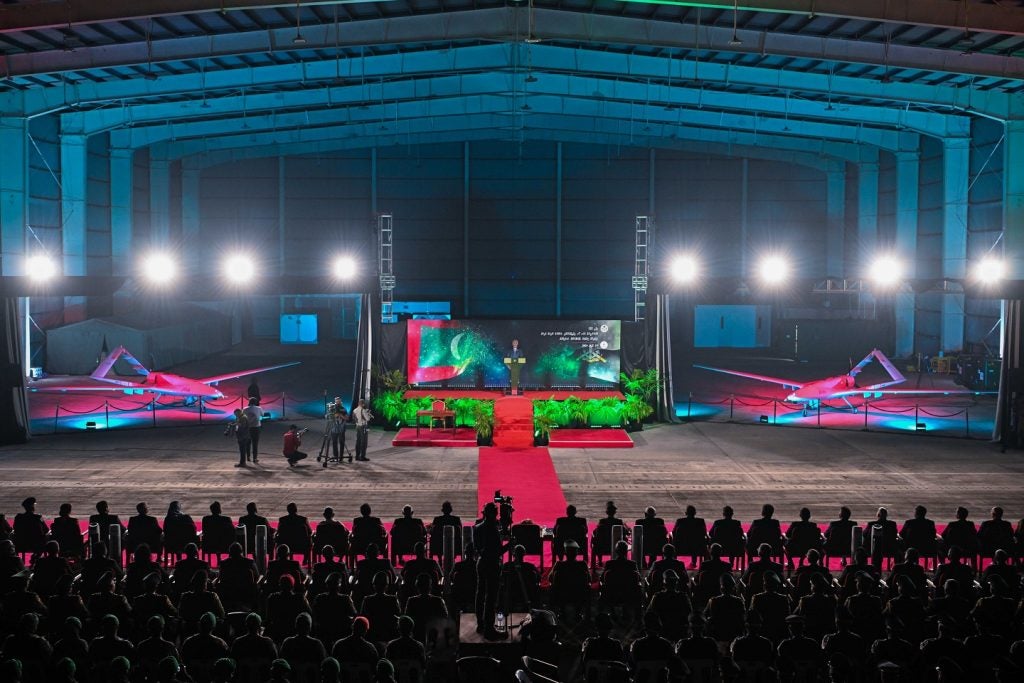

Over the last decade, tactical UAVs have become a common sight over combat zones such as Iraq and Afghanistan. The small aircraft don’t require a runway, like the much bigger MQ-1 Predator or RQ-4 Global Hawk, and can instead be catapulted into the air from the back of a trailer. Once in the air, they can relay real-time video to ground forces and even laser designate targets for other weapon platforms.
During one deployment to Afghanistan, US Marines counted 94 "high-value" targets which were spotted using an RQ-7 Shadow UAV. But in each instance, a weapons platform was not immediately available to the US Marines on the ground so the targets escaped. Incidents like these have been particularly frustrating for commanders and have led to the question: why not weaponise our tactical UAVs?
An armed RQ-7 Shadow, the US Army’s workhorse UAV, would allow forward-deployed troops to not only conduct surveillance but also rapidly engage fleeting targets – such as mortar teams, terrorists planting an IED or an enemy pick-up truck – before they can disappear. It would also be ideal for busy urban areas, where it’s often impossible to drop a large air-to-surface bomb, such as a JDAM, or use other fire support weaponry like artillery.
A low-cost alternative to expensive weapons
One other advantage of smaller guided bombs is cost. They are significantly cheaper than large air-to-surface missiles, such as the MBDA Brimstone used by the Royal Air Force, because they lack the range, lethality and complexity these systems offer. Small bombs can give greater operational flexibility, allowing commanders to use a mini smart bomb against soft targets such as personnel and unarmoured trucks and heavier bombs for hard targets.
The recent airstrikes against Islamic State in Iraq are a good example of this. Many question why the RAF uses a Brimstone missile costing £100,000 against soft targets such as pick-up trucks, when surely there are more affordable alternatives? A small UAV, loaded with a relatively cheap glide bomb could achieve the same effect at a fraction of the cost.
How well do you really know your competitors?
Access the most comprehensive Company Profiles on the market, powered by GlobalData. Save hours of research. Gain competitive edge.

Thank you!
Your download email will arrive shortly
Not ready to buy yet? Download a free sample
We are confident about the unique quality of our Company Profiles. However, we want you to make the most beneficial decision for your business, so we offer a free sample that you can download by submitting the below form
By GlobalDataRussian and American militaries experimented with nuclear powered aircraft for two decades.
The impetus for arming smaller UAVs mirrors the development of the weaponised MQ-1 Predator, an aircraft which, like the Shadow, was initially conceived as an intelligence, surveillance and reconnaissance platform. For its strike role, the Predator was quickly adapted and could use existing guided munitions like the AGM-144 Hellfire, which was successfully integrated in 2001. Arming tactical UAVs – of which there are hundreds in the US military alone – could be the next transformative step for unmanned aircraft on the battlefield.
One hurdle for arming smaller UAVs has been the lack of existing lightweight smart bombs. To be carried on tactical drones, like the Shadow, a bomb would have to weigh around 10kg and yet still be precision-guided in order to avoid collateral damage and maintain lethality. Importantly, a light munition means a tactical UAV can retain its surveillance capabilities and its time-on-station performance.
In 2010, the US military released a request for information for an all-new class of precision weapons weighing 11.3kg or less. Industry reacted quickly and almost all leading missile manufacturers have announced lightweight weapon systems that adhere to these requirements.
To achieve these unprecedented low weights manufacturers have had to scrap heavy rocket motors – most mini-munitions are guided gravity bombs – and also significantly miniaturise guidance technology such as laser seekers.
Industry enters the small bomb market
Raytheon unveiled its small tactical munition – now known as the Pyros – with an advanced semi-active laser and three choices of guidance including GPS, inertial navigation and laser designation. At 55cm long and weighing only 6kg, the Pyros is ideally suited for tactical UAVs and can even be programmed for height-of-burst, point-of-impact or fuse-delay detonation. Being able to choose how the bomb detonates increases its effectiveness against a broad range of targets.
In 2012, the Raytheon completed the first successful demonstration of its Pyros warhead and guidance system, hitting a target which simulated a group of insurgents planting an IED. In the same year Lockheed Martin also successfully tested its own laser-guided glide bomb, called Shadow Hawk, on a Shadow UAV. Lockheed’s Shadow Hawk weighs around 5kg and, like the Pyros, is most effective against unprotected personnel.
Manufacturers MBDA and General Dynamics Ordnance and Tactical Systems (GD OTS) have also led efforts to weaponise the Tiger Shark, a UAV similar in size to the Shadow. As part of its Air Drop Mortar programme, GD OTS fitted a Tiger Shark with a standard US Army 81mm mortar equipped with a smart guidance system. MBDA has developed the 4.5kg Saber, which is similar to offerings from Lockheed and Raytheon and can also hit moving targets.
Possibly the most innovative mini-guided bomb is the ATK Hatchet, reportedly developed with funding from the US Air Force Research Laboratory. The extremely tiny munition – similar in size to a 30mm cannon round – weighs less than 3kg yet still retains precision guidance with a semi-active laser. It has even been proposed that larger aircraft such as the MQ-1 Predator could carry tens, if not hundreds, of Hatchets to create a ‘cluster bomb’ effect.
A swarm of smart bombs has the potential to revolutionise airstrikes on the modern battlefield, but this technology is still in its very early days.
In September this year, Textron – the manufacturer of the Shadow UAV – successfully conducted the first live-fire test of its own miniature guided bomb – marking its entry into the niche market. The Fury is a modified Thales UK Lightweight Multirole Missile (LMM) and features the same warhead and state-of-the-art Selex ES semi-active laser.
While Texton’s main focus is the nascent UAV market, it is also keen to see the Fury utilised on larger aircraft. Textron is marketing the Fury as a capable weapon for smaller attack platforms such as its twin-engined Scorpion fighter jet – currently being developed with AirLand Enterprises.
Argentina has launched a bid to acquire 24 Saab Gripen E fighter jets off the back of a deal with Brazil.
At this year’s Farnborough Airshow, the Fury was displayed on a Beechcraft AT-6 light attack aircraft. In standard configuration, three miniature Fury bombs can fit, one behind the other, on a standard missile rail. An aircraft like the MQ-1 Predator, which can carry up to four Hellfire missiles, would be able to carry twelve Fury bombs.
Beyond Afghanistan – the future of small bombs
What’s the future for the small bomb and armed UAV? While manufacturers have shown they are more than capable of developing the technology, it seems militaries around the world are still cautious about buying into the concept. The US military is yet to decide if it really wants to arm its small UAVs and has not ordered any of the systems mentioned above.
The original requirement for small bombs fitted to UAVs was borne out of the Afghanistan conflict and the circumstances soldiers were facing in that particular warzone. Will the next conflict present the same challenges? Now that the Afghanistan war is all but finished, it might spell the end of small guided bomb experiment. Back at home, there will also be significant opposition from ‘killer drone’ activists who see the weaponisation of hundreds of UAVs as a step in wrong direction.


.gif)




